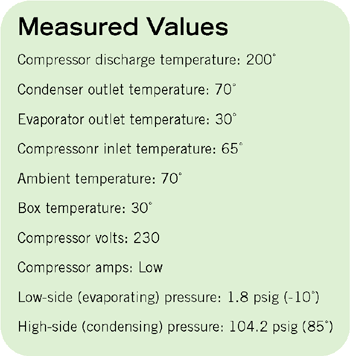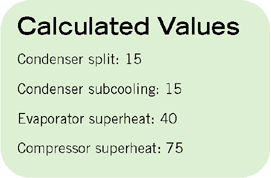The refrigerant being used is R-134a. Very similar results will occur if an automatic expansion valve (AXV) is being used. However, because different refrigerant system configurations may apply when using capillary tubes as metering devices, different system symptoms may occur. The intent of this article is to explore how a partially restricted TXV will affect system performance and efficiency and what symptoms will occur.
Listed below are ways the TXV can become restricted:

Symptoms
A system with a restricted metering device has the same symptoms as a system with a liquid line restriction that occurred after the receiver. This is because the TXV is actually part of the liquid line. A TXV being restricted will cause the evaporator, compressor, and condenser to be starved of refrigerant. This will cause low suction pressures, high superheats, low amp draws, and low head pressures.Also, the symptoms of a restricted TXV system are very similar to a system with a refrigerant undercharge. However, the undercharged system will have low subcooling levels. Technicians often confuse an undercharged system with a restricted metering device. Adding refrigerant to the system with a restricted metering device will only raise the subcooling amounts to a level where the head pressure may elevate. This is caused by a lack of internal volume to hold the added refrigerant. Even the receiver may overfill if too much refrigerant is added.
Table 1 is a system checklist for a system with a restricted metering device. Table 2 shows the calculated values for the condenser split, condenser subcooling, evaporator superheat, and compressor superheat.

High Discharge Temperature
Somewhat high discharge temperatures are caused from the higher superheats from the evaporator being starved of refrigerant. The compressor is now seeing a lot of sensible heat coming from the evaporator and suction line, along with its heat of compression and motor heat. The compressor will probably overheat from the lack of refrigerant cooling if it is a refrigerant-cooled compressor.Low Condensing (Head) Pressures
Since the evaporator and compressor are being starved of refrigerant, so is the condenser because these components are in series with one another. There will be little heat to eject to the ambient surrounding the condenser. This allows the condenser to operate at a lower temperature and pressure.Lower Condenser Splits
Since the condenser is being starved of refrigerant, it can operate at a lower temperature and pressure. This is because it does not need a large temperature difference between the ambient and the condensing temperature to reject the small amount of heat it is getting from the evaporator, suction line, and compressor.This temperature difference is referred to as the condenser split. If there were large amounts of heat to reject in the condenser, the condenser would accumulate heat until the condenser split was high enough to reject this large amount of heat. High heat loads on the condenser mean large condenser splits. Low heat loads on the condenser mean low condenser splits.
Condenser Subcooling
Most of the refrigerant will be in the receiver, with some in the condenser. The condenser subcooling will be normal to a bit high because of this. The refrigerant flow rate will be low through the system from the restriction. This will cause what refrigerant there is in the condenser to remain there longer and subcool more. Note that an undercharge of refrigerant will cause low subcooling.Low Evaporator Pressures
Since the evaporator is starved of refrigerant, the compressor will be starving also and will pull itself into a low-pressure situation. It is the amount and rate of refrigerant vaporizing in the evaporator that keeps the pressure up. A small amount of refrigerant vaporizing will cause a lower pressure.High Superheats
High superheats are caused by the evaporator and compressor being starved of refrigerant. With the TXV restricted, the evaporator will become inactive and run high superheat. This will cause the compressor superheat to be high. The 100 percent saturated vapor point in the evaporator will climb up the evaporator coil, causing high superheats.Low Amp Draw
High compressor superheats and low suction pressures cause low-density vapors to enter the compressor. Also, the compressor will be partly starved from the TXV being restricted. These factors will put a very light load on the compressor causing the amp draw to be low.LPC Short Cycle
The compressor may short cycle on the low-pressure control (LPC) depending on how severe the restriction in the TXV is. The low suction pressures may cycle the compressor off prematurely.After the short period of time, the evaporator pressure will slowly rise from the small amount of refrigerant in it and the heat load on it. This will cycle the compressor back on. This short cycling may keep occurring until the compressor overheats.
Tomczyk is a professor of HVACR at Ferris State University, Big Rapids, Mich. He can be reached by e-mail at tomczykj@tucker-usa.com.
Publication date: 03/01/2004

Report Abusive Comment